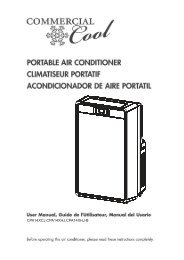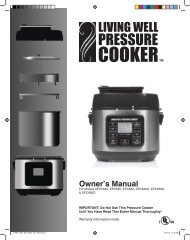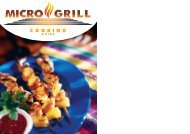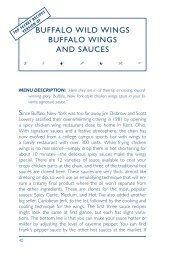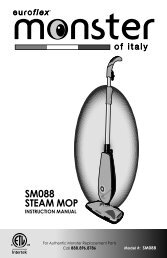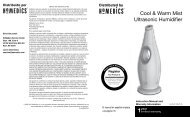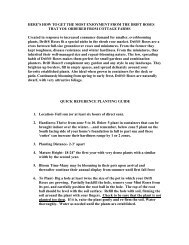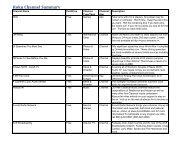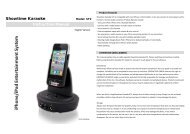BOWL-LIFT STAND MIXER BATTEUR À BOL AMOVIBLE ... - QVC.com
BOWL-LIFT STAND MIXER BATTEUR À BOL AMOVIBLE ... - QVC.com
BOWL-LIFT STAND MIXER BATTEUR À BOL AMOVIBLE ... - QVC.com
You also want an ePaper? Increase the reach of your titles
YUMPU automatically turns print PDFs into web optimized ePapers that Google loves.
MIXING TIPS<br />
Converting Your Recipe<br />
for the Mixer<br />
The mixing instructions for recipes<br />
in this book can guide you in<br />
converting your own favorite recipes<br />
for use with your KitchenAid ® Stand<br />
Mixer. Look for recipes similar to<br />
yours, and then adapt your recipes<br />
using similar procedures.<br />
For example, the “quick mix” method<br />
(sometimes referred to as the<br />
“dump” method) is ideal for simple<br />
cakes, such as the Quick Yellow<br />
Cake and Easy White Cake included<br />
in this book. This method calls for<br />
<strong>com</strong>bining dry ingredients with most<br />
or all-liquid ingredients in one step.<br />
More elaborate cakes, such as<br />
Caramel Walnut Banana Torte,<br />
should be prepared using the<br />
traditional cake mixing method. With<br />
this method, sugar and shortening,<br />
butter, or margarine are thoroughly<br />
mixed (creamed) before other<br />
ingredients are added.<br />
For all cakes, mixing times may<br />
vary because your KitchenAid ®<br />
Stand Mixer mixes faster than most<br />
other mixers. In general, mixing<br />
a cake with a KitchenAid ® Stand<br />
Mixer will take about half the time<br />
re<strong>com</strong>mended in most cake recipes.<br />
To help determine the ideal mixing<br />
time, observe the batter or dough<br />
and mix only until it has the desired<br />
appearance described in your recipe,<br />
such as “smooth and creamy.” To<br />
select the best mixing speed for the<br />
job, use the Speed Control Guide<br />
on page 18.<br />
Adding Ingredients<br />
Always add ingredients as close to<br />
the side of the bowl as possible, not<br />
directly into the moving beater. The<br />
Pouring Shield* can simplify adding<br />
ingredients. If the ingredients in the<br />
bottom of bowl are not thoroughly<br />
mixed, then the beater-to-bowl<br />
clearance must be adjusted. See<br />
page 20 for instructions.<br />
Cake Mixes<br />
When preparing packaged cake<br />
mixes, use Speed 2 for low speed,<br />
Speed 4 for medium speed, and<br />
Speed 6 for high speed. For the best<br />
results, mix for the time stated on<br />
the package directions.<br />
Adding Nuts, Raisins, or<br />
Candied Fruits<br />
Follow individual recipes for<br />
guidelines on including these<br />
ingredients. In general, solid materials<br />
should be folded into the mix during<br />
the last few seconds of mixing on<br />
the STIR Speed. The batter should<br />
be thick enough to prevent the fruit<br />
or nuts from sinking to the bottom<br />
of the pan during baking. Sticky<br />
fruits should be dusted with flour for<br />
better distribution in the batter.<br />
Liquid Mixtures<br />
Mixtures containing large amounts<br />
of liquid ingredients should be mixed<br />
at lower speeds to avoid splashing.<br />
Increase the speed only after the<br />
mixture has thickened.<br />
ENGLISH<br />
* If Pouring Shield is included.<br />
21




